Rock-Mites are crystal controlled transceivers from SWL designed by Dave Benson.
A significant feature of this fun little gem is the PIC keyer controller. Not something often found on a $27 rig.
In addition to the original 20 and 40 meter kits, I’ve mod'ed them for 80, 30 and 15 meters — all worked.
Dave now has models for 80 and 30 meters and the new HiMites for 20, 15 and the higher bands.
Back to Contents
View/Download Bifilar Output Mod —Bifilar Output PDF
View/Download Dual Crystal Input Filter Mod —Dual Crystal PDF
| R-M/40 Chuck Wagon | This was a fun assembly but it wasn’t easy to work on for making mods and experimenting. So the RM was removed from this enclosure and assembled into the PCB frame shown in pictures below. | 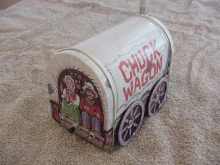 |
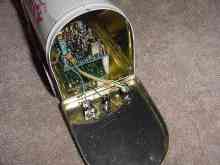 |
Inside view of the RM in place in the wagon. Jacks for the headphone and paddle along with the shift pushbutton are on the front. Power connection and BNC antenna jacks are on the back. |
| R-M/40 PCB U-Chassis | 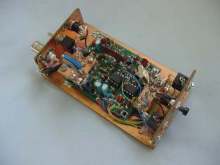 |
Here’s my original R-M/40 in the PCB U-frame chassis. Jacks for the headphone and paddle along with the shift pushbutton are on the front. Power connection and the BNC antenna jacks are on the back. |
| Several mods and enhancements were added using additional PCB platforms mounted on the frame. On the right end in the picture the trimmer capacitor and DIP pins for the VXO mod. With a 7042 crystal from ESS, operation at 7044 was possible. At the top center, the blue pot is the FET RF gain control. Simpler would be the 1 meg pot at R5 but this was more fun. | ||
| Machined DIP Pins | Machined DIP pins removed from IC sockets are used in key component locations. This makes it easy to do band changes. Or just plain experiment with mods and other enhancements. In this picture, a socket was used at Q6. Other times, 3 DIP pins were used as a socket. As a minimum, DIP pins could be used for Y1, Y2, C8, R5, R18 and Q6. I didn’t do R5 on this board but have on subsequent RM construction. | 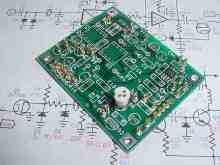 |
| R-M/20 in Context Box | 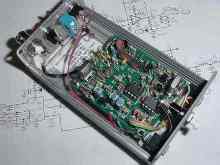 |
Here’s my original R-M/20 in a Context box. Jacks for the headphone and paddle along with the shift pushbutton are on the front. Power connection and the BNC antenna jacks are on the back. Enclosures from Context Engineering turned out to be my favorites. |
| I paint most of my boxes with a gray color I like. Context boxes, number 2506 here, are available from Fry’s Outpost as at least one source of supply. The R-M mounting in this one is too close to the front panel. Doing it again I’d move it back a little. The parts on the front panel are a little crowded and made it difficult to make connections. | ||
| Super Rock-Mite | This one won a prize for packaging at ArkieCon a couple of years ago. The enclosure is a black Context box # 4006B. The front panel includes a speed control for the RMK keyer chip, filter in/out switch, and FET RF gain control. Power, power on/off, straight key mode button, internal/external power selector and BNC are on the back panel. A 10-cell battery pack and the KD1JV filter are included with the R-M in the enclosure. . | 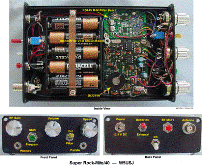 |
| R-M/20 in BLT Enclosure | A 20 meter Rock-Mite with VXO was built and installed in this enclosure.
Hendricks QRP Kits no longer sells this box which is the same size as their BLT.
The assembly is a little crowded but along with the BLT, it makes a nice combo setup.
RM BLT Combo |
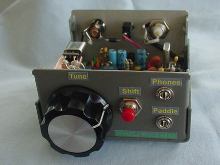 |
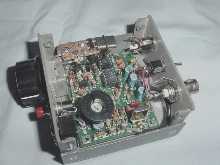 |
Inside view showing the VXO circuit. The VXO circuit uses the small section from a poly cap variable in series with a 10 ÁH choke. Both parts are in series with crystal Y2 on the D5 side. |
| Rock-Mite Enclosures | Shown here are my other R-M enclosures. On the left is the PCB frame shown above. Top center is the Context box. My second favorite is the LMB CR-425 box. Mouser sells this one. On the bottom is another Context box housing my Super R-M. This box is Context number 4006B, 4x1.5x6. At the time this picture was taken, the labels for the controls were not there. They are now. The two R-Ms on top are now sold and enjoying new homes. | 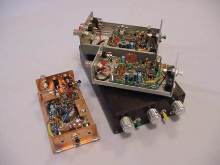 |
| 80 Meter Rock-Mite 3-Crystal Frequencies | Built this for a Ham out in the Marshall Islands. The crystals are selected from the front panel. A neat fiberglass and plastic switch was used for this project. Latest word from the islands "the 80 meter Rock-Mite is working great". Front panel controls include: Program Shift button, Phones and Paddle jacks, Volume (top) and crystal select switch. | 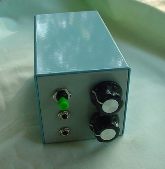 |
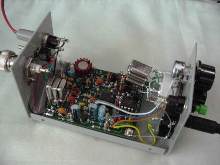 |
Inside view of the 3-frequency 80 meter Rock-Mite. The 3 receive crystals are connected in parallel. The transmit crystals are wired to the panel switch. An LMB CR-422 was used for the enclosure. |
Rock-Mite/40 Schematic
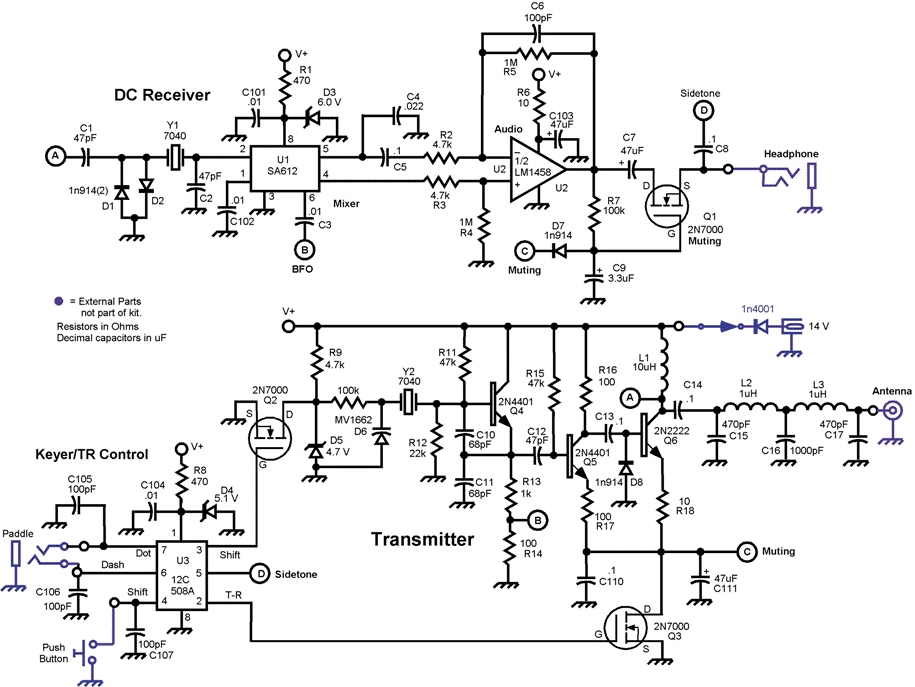
Visual SWR Brige and Mini Mint Tin
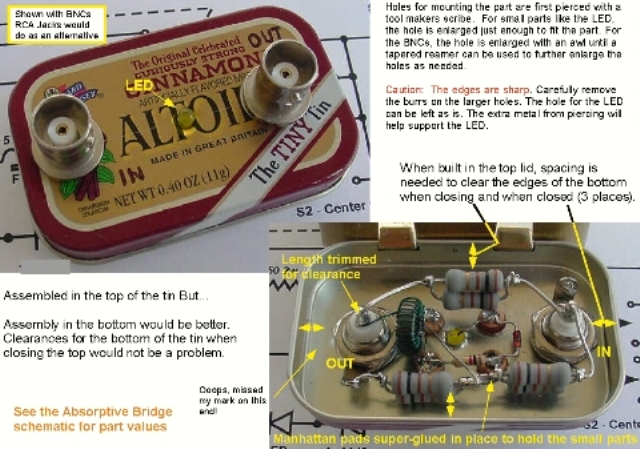
30 Meter R-M Mods
Here's what I'm currently using with my 30 meter Rock-Mite.
Crystals: 2 ea 10.116 from NorCal and/or 10.106 from N4ESS
C10,11 = 47 pF C0G/NP0 (negative/positive zero)
C12 = 39 pF C0G/NP0
R18 = 7.5 Ohms w/2N2222A and heatsink — 2 Ohms w/2N2219A
Filter values were determined from the SVC tables in the ARRL Handbooks.
L1 = 12 t #26 on FT37-43
L2,3 = 20 t #26 on T37-6
C15,17 = 330 pF
C16 =560 pF
D5 = adjust voltage for ~750 Hz shift - try 5.1 or 4.7. The voltage in my
R-M/30 is 4.9. Depending on parts tolerances, YMMV [rev2a]
I'm putting small value capacitors in series with the crystals to get them
on frequency. Most of those I've tried tend to oscillate a kHz or 2 low.
(added note: The frequency is affected by the values used for C10,11)
Actually, I only put a cap on one crystal. Then I switch them between Y1
and Y2 to give me two different frequencies. I use machined DIP pins as sockets.
With the 10.116 crystals I have, they oscillated at ~10.114. A 33 pF moved
one back to ~10.116 and 10 pF moved another to ~10.120. YMMV.
All R-Ms seem to be sensitive to matching. Q6 is likely to get hot(ter) if
you tune into an unmatched load. A 50 Ohm absorptive bridge for tuning is
a good idea, e.g., a tuner such as the NorCal BLT sold by Hendricks QRP Kits.